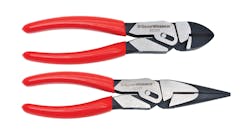Tool Review: GearWrench PivotForce Compound Action Long Nose and Cutting Pliers
Utilizing the mechanical advantage of an innovative compound action joint, GearWrench PivotForce Compound Action Pliers require 40 percent less force to cut than regular pliers, according to the company. The unique design delivers a more efficient transition of power from the handle to the jaws, enabling users to make the same cuts with less effort. The dipped handles provide added comfort and have an easy-to-clean gloss finish. The pliers also meet or exceed all applicable ASME specifications. They feature induction-hardened cutting edges for enhanced product life. They are designed with standard bevel edges for general wire cutting. The pliers are available in long nose and diagonal cutting variations; the long nose model has a machined, crosschecked jaw pattern, which assists in gripping and twisting in any direction. The pliers are made of forged steel for superior strength and durability, and have an anti-rust coating to guard against corrosion.
The review
Eric Moore, co-owner of DeMary Truck, recently tested the GearWrench PivotForce Compound Action Long Nose and Cutting Pliers at his shop in Columbus, Ohio.
Moore put the products to the test by using them for a variety of different tasks around the shop. He found the long nose pliers to be handy for removing clips and vacuum lines, while the cutting pliers were well-suited for wiring, cable shortening, wire stripping and removing chrome covers on lugnuts.
“I found that The GearWrench PivotForce Pliers made cutting thicker gauge wire much less tiresome and efficient, rather than having to return to the toolbox for a cable cutting plier,” Moore says.
Though he has used pliers of all sizes and configurations in the past, Moore was able to identify a handful of features of the GearWrench PivotForce Compound Action Long Nose and Cutting Pliers that stood out to him.
“I am fond of the additional grip force with the long nose pliers, and the ability of the cutting pliers to handle larger diameter cabling than the typical cutting pliers everyone has in their arsenal,” he says.
Moore characterized the products as “extremely easy to use.” He also noted that he “liked the additional clamping force that is capable of being applied simply by squeezing a little harder.”
However, he also offered a few suggestions on how the GearWrench PivotForce Compound Action Long Nose and Cutting Pliers could stand to improve.
He says he found the PivotForce pliers to be a little stiff while opening and closing, at least until he applied penetrant and started using them more often. Wider jaw openings and longer handles for certain applications would also be ideal, Moore adds.
“Pliers are hard to gauge, unless they are for specific use and dramatically reduce the labor related to the task they are designed for,” he continues. “Neither of these did exactly that, but I do feel comfortable rating them a solid eight (out of 10).”




